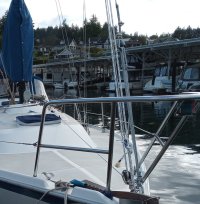Pop, sproing, crash in the middle of the night. Headlamp up to see a broken shroud or two and the mast in the water.
The boat is probably leaned over and trapped by dragged mast. The sails are in the water, arresting motion.
If the wind was strong enough to bring down the rig, you're probably pretty puckered.
Probably the mast is still folded/attached to itself. I think some steps would be:
1. Ascertain if the sails and rigging can be brought safely alonside the boat.
2. Probably the mast will need to be cut off entirely. The cut end of the mast will be sharp and could put a hole in the boat depending on how the loads push it.
3. It may make sense to cut attached shrouds/stays first or second.
Bring a hacksaw.
Bring an effective means of cutting stays (cable cutters / reefing knife for synthetic)
Other ideas?
The boat is probably leaned over and trapped by dragged mast. The sails are in the water, arresting motion.
If the wind was strong enough to bring down the rig, you're probably pretty puckered.
Probably the mast is still folded/attached to itself. I think some steps would be:
1. Ascertain if the sails and rigging can be brought safely alonside the boat.
2. Probably the mast will need to be cut off entirely. The cut end of the mast will be sharp and could put a hole in the boat depending on how the loads push it.
3. It may make sense to cut attached shrouds/stays first or second.
Bring a hacksaw.
Bring an effective means of cutting stays (cable cutters / reefing knife for synthetic)
Other ideas?

